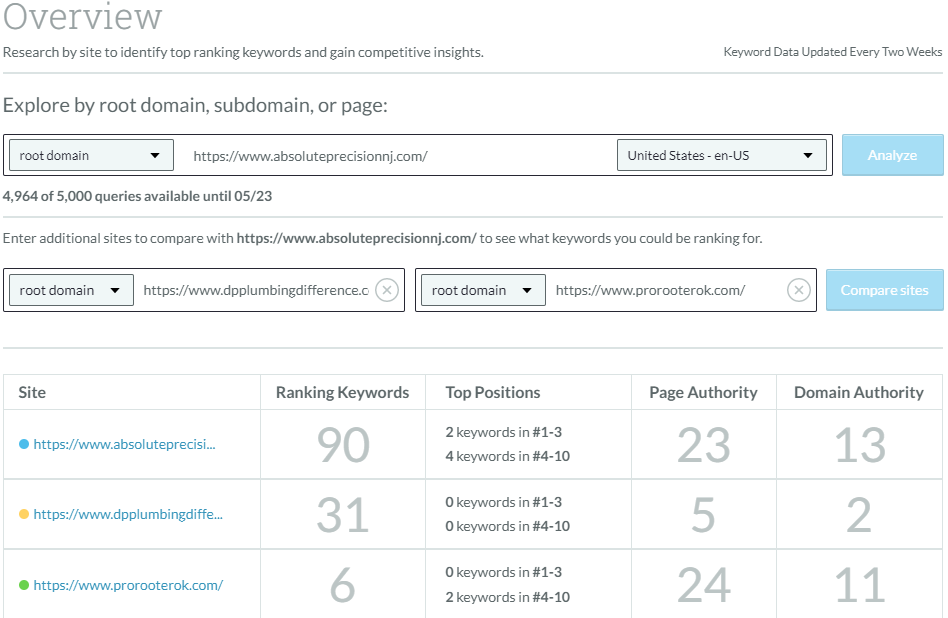SEO competitor analysis for plumbers is one of the fastest ways to identify marketing opportunities.
Through competitor research, plumbing companies can discover overlooked opportunities for keywords, links, and conversions.
Make no mistake: the most successful companies are taking cues from their direct competitors to increase sales.
Keeping a close eye on your competition can help you emulate their success, find opportunities in their SEO strategy, and exploit their weaknesses.
In the following post, HVAC-Plumber SEO Webmasters will discuss SEO competitor analysis, why it is essential, and how to use it to your advantage.

Key Takeaway
Using tools like SEMRush, plumbers can reverse engineer the best qualities of their competitors’ websites.
Perspective on SEO Competitor Analysis
Focusing solely on your own plumbing website’s keywords, content, and backlinks can cause tunnel vision, resulting in missed opportunities for plumbing leads.
When restricting analysis to your own keywords and rankings, you lose objectivity.
Soon, all that exists is your plumbing website and your unchallenged beliefs about its effectiveness.
The key to dominating your market through plumbing marketing and SEO is to understand what your competitors are doing and why they are doing it.
SEO competitor analysis provides a fresh perspective that allows plumbers to identify areas for improvement and close the gap between keywords and website authority.
Competitor analysis for plumbers allows you to look at the market as a whole and see where you stand instead of where you think you stand.
Analyzing competitors’ SEO campaigns is essential, even if you currently rank well for target keywords, as it can help you stave off new local companies vying for those positions.
Identifying Competitor Strategies
Identifying your competitors is the basis for analyzing them. For example, choose the top three to six plumbing websites targeting your general service area.
Using a tool like SEMRush, Ahrefs, or Moz, search for your primary keyword [plumber (city,st)] and find the top 3 positions in Google’s Map 3-Pack and traditional organic results.
Some of these companies may overlap (meaning they rank in the map 3-pack and organic), while others may only rank in one of these areas.
Once you find your main competitors, you can analyze their entire websites using SEMRush, Ahrefs, or Moz.
You can also directly compare your keyword rankings to theirs to see who is ranking higher for specific terms or whether they are ranking for terms you are not.
Identifying keywords your website is not ranking for (but competitors are) is known as keyword gap analysis, a subtopic of competitor analysis.
For example, the plumbing company ranking #1 on organic search results for [plumber] may also rank for subcategories like [slab leak repair], [hydrojetting], and [burst pipe repair].
Analyzing the Competition
Any effective competitor research will require a keyword research tool such as Moz, SEMrush, or Ahrefs.
Each platform helps identify various components of a website’s SEO campaign, including ranking keywords, estimated website traffic, and backlink profile.
Once you have all your analysis tools fired up, check for the following:

Source: MOZ Keyword Explorer
Missing Keywords
Most tools will allow you to see your competitor’s ranking keywords and compare them to yours.
The comparison reveals if you have any keyword gaps or keywords that you have omitted but could still earn you traffic. It may also inform what new pages or content you must add to your site.
Backlink Profile
Backlinks are the number one driver of website authority, often measured by third-party metrics such as Domain Authority (DA), Domain Rating (DR), and Authority Score.
You can compare your website’s metrics to those of your competitors and identify which domains link to competitor websites.
You may find domains from highly relevant sources (like plumbing suppliers or chambers of commerce) that would also be willing to link to your website.
While closing the backlink gap between your site and your competitors is almost always a positive development, it’s essential to understand that these metrics are merely estimates and are not used by Google for rankings.
However, Google likely has an internal scoring mechanism similar to the ones utilized by these third-party tools.
As a result, follow the best link building practices for plumbing websites based on your competitor analysis findings.
Page Traffic
Examining which pages on your competitor’s site are the most popular is also essential, as these often accumulate the most backlinks.
Some popular pages rank for more than one keyword, which indicates that the page satisfies a broader user intent such as [plumbing services].
Comparing these pages to yours can help you understand which subtopics you might have overlooked and how you can better meet the user intent of the primary term.
Consumer Opinion
Asking your customers and site visitors for feedback is another way to accumulate research data for competitor analysis.
If you have an email subscriber list, send out a questionnaire about your site’s user experience.
Feedback can provide valuable consumer insight into your website’s strengths and weaknesses.
Long-Tail Discrepancies
Even if it seems like your competitor lacks weaknesses, they likely have some vulnerabilities related to long-tail keywords.
Plumbing websites that rank well for primary terms like [plumber] and [plumbing company] might rest on their laurels for long-tail terms that drive traffic on the margins.
The keyword research tools will not pick up all long-tail keywords, but Moz Keyword Explorer is the best at tracking them.
Content Quality
It is also essential to compare your competitors’ sites’ written and video content to your own.
Google will penalize you for low-quality content, so you may be ranking lower for specific keywords purely because of content.
Mass-producing low-quality blog posts can weaken your site-wide signals, negatively affecting service pages and your homepage.
Navigability
Sometimes, technical issues may hamper your rankings, so studying the user experience of your competitor’s websites can also provide valuable insight.
Navigate your top competitor’s sites through the eyes of a potential customer and then compare that experience to your own website.
Do they have any dead links? Is their site easy to navigate? Does every page link to another? Now, does yours?
Answering these questions can lead to quick wins in improving your website’s user experience and conversion rates.
Final Thoughts on Competitor Analysis
Monitoring competitor websites for new opportunities is part of digital marketing.
While creating original content with unique insights is always great, analyzing competitors’ sites can provide a roadmap to dominating your local search results.
While keywords and content topics are the most obvious things to analyze on a competitor’s website, evaluating their site’s user experience and design is also helpful.
While you won’t use everything you consume from other websites, they will help you maximize the value of your own company’s website.






